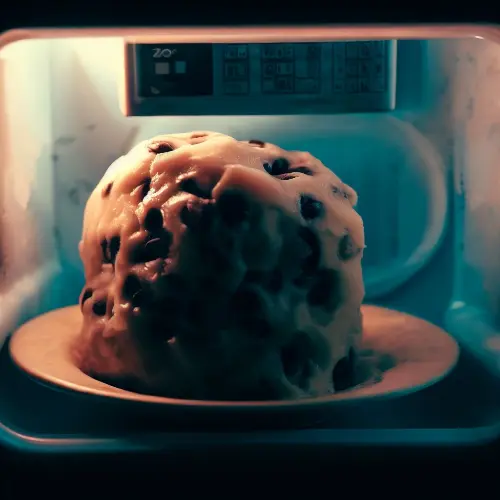Thekitchenkits.online is an Amazon Associate and earns from qualifying purchases made through affiliate links on our site at no extra cost to you. This supports our efforts to bring you valuable kitchen-related content.
Table of Contents
Can You Microwave Frozen Cookie Dough
Yes, you can microwave frozen cookie dough, but it may not yield the same texture and flavor as conventional baking. Microwaving frozen cookie dough is a quick and easy way to bake fresh, homemade cookies without turning on your oven.
While microwave cooking may not produce the exact same results as traditional oven baking, microwaving frozen cookie dough can be a convenient method for enjoying warm, chewy cookies in a fraction of the time.
Is It Safe to Microwave Cookie Dough?
A common concern with microwaving cookie dough is whether it is safe to eat. The main risk with raw cookie dough is the potential presence of raw eggs, which carry a small chance of salmonella contamination.
However, most premade cookie doughs sold in stores use pasteurized eggs or egg substitutes, making them safer to consume raw or undercooked.
As long as you are using store-bought cookie dough that has been handled properly, microwaving it provides enough heat to kill any harmful bacteria that may be present. Homemade cookie dough or dough containing raw eggs should always be fully cooked before eating.
When microwaving cookie dough, it is important to cook the dough thoroughly until it has an internal temperature of 160°F. This ensures any raw flour or eggs are fully cooked through. If you are concerned about eating raw dough, microwaving is a good way to eliminate food safety risks.
How to Microwave Frozen Cookie Dough
Microwaving frozen cookie dough is a simple process that allows you to skip preheating the oven and waiting for a traditional bake time. Here are step-by-step instructions:
- Take frozen cookie dough out of the freezer and allow to soften slightly, about 5 minutes. This makes it easier to scoop.
- Scoop rounded dough balls, about 1-2 tablespoons each, and place on a microwave-safe plate. Leave 1-2 inches between dough balls to allow for spreading.
- Microwave the cookie dough in 30-second intervals until the dough is soft, puffy, and cooked through, checking frequently. The time will depend on your microwave wattage and the amount of dough.
- Allow cookies to cool slightly before removing them from the plate, as they will be very hot and soft immediately after microwaving. The cookies will firm up after a minute or two of cooling.
- Optional – For more flavor, mix in chocolate chips, nuts, or other mixins before scooping the dough.
Microwave Cookie Dough Tips
Use smaller dough balls rather than large scoops, as large amounts of dough may not cook evenly.
Avoid overcrowding the plate with too many dough balls touching. Leave space between them.
Microwave in short intervals, such as 30 seconds at a time, until the dough has puffed up and appears baked through. Check frequently to prevent overcooking.
Adjust cook times based on your microwave wattage. Higher-wattage microwaves will cook faster.
- Flip the dough balls halfway through cooking for more even cooking.
- Let dough come to room temperature before scooping if it’s been in the freezer for a while, so it microwaves more easily.
- Use a microwave-safe plate rather than plastic which may melt from heat.
- Metal pans or racks should not be microwaved as they can damage the microwave or cause arcing.
Can You Microwave Any Cookie Dough?
In theory, both homemade and store-bought cookie dough can be microwaved to bake cookies without an oven. However, some types work better than others:
- Refrigerated dough tends to microwave better than frozen, as there is less thawing needed.
- Drop cookie dough like chocolate chip or sugar cookie dough and spread nicely during microwaving.
- Slice-and-bake cookie dough may hold its shape better without spreading too thin.
- Shortbread doughs with a high-fat content can end up greasy. Reduce cooking time for buttery doughs.
- Cookies made from cake mix dough or other soft doughs may spread into very thin, dense cookies rather than rising.
While you can microwave most standard cookie doughs, you may need to experiment to get ideal results depending on the recipe. Start with 30-second intervals and adjust time as needed.
FAQs
Is microwaved cookie dough safe to eat?
As long as store-bought cookie dough or properly handled homemade dough is cooked thoroughly, it is safe to eat after microwaving. Ensure no raw dough remains.
Do microwaved cookies taste as good?
While microwaved cookies will be slightly different than oven-baked, they can still taste delicious! They will be chewy on the inside with a tender, cakelike exterior. Allow to cool completely to firm up.
Can I use an oven instead?
Yes, you can microwave cookie dough to thaw it and then bake as normal in the oven for more traditional results. Microwaving may also be used to pre-bake before a short oven finish.
What is the best microwave time for cookie dough?
Times vary based on dough amount and microwave wattage. Start with 30 seconds and check frequently until puffed and set. Most dough takes 1-3 minutes total time. Watch closely to avoid burning.
Should I let the dough thaw first?
Microwaving dough straight from the freezer can work, but allowing it to thaw for 5-10 minutes makes scooping easier and allows for more even cooking.
Can I microwave cookie dough in a mug?
Yes, a microwave-safe mug works well for single servings! Grease the mug first for easy removal.
Can I top microwaved cookie dough with ice cream?
Definitely! Warm cookie dough topped with a scoop of ice cream makes an instant dessert. The heat slightly softens the ice cream.
The Bottom Line
While the texture may be a bit different, microwaving cookie dough is a fast and simple way to enjoy fresh-baked cookies without turning on your oven.
When using prepared dough and microwaving with care, it can be a safe and tasty treat. Give it a try the next time a cookie craving strikes!

I’m Ian Welkins, a seasoned professional in the kitchen industry. My passion now drives me to provide invaluable insights into the world of top-notch kitchen products. With years of hands-on experience, I’m your go-to source for culinary excellence.


